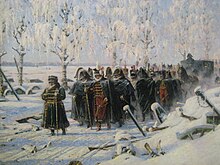1812 battle during Napoleon's invasion of Russia
| Battle of Kaidanowo | |||||||
|---|---|---|---|---|---|---|---|
| Part of the French invasion of Russia | |||||||
 Napoleon's retreat by Vasily Vereshchagin | |||||||
| |||||||
| Belligerents | |||||||
|
|
| ||||||
| Commanders and leaders | |||||||
|
|
| ||||||
| Strength | |||||||
| 3,800–4,000 | 1,300–2,000 | ||||||
| Casualties and losses | |||||||
| Unknown | 1,000–2,000 | ||||||
300miles Kaidanowo Pultusk15 Gorodeczno14
slavets7
The Battle of Kaidanowo was fought on Sunday, 15 November 1812, near the village of Kaidanowo, part of the Russian Empire at the time. A Lithuanian, Württembergian, and French force under General Franciszek Ksawery Kossecki [pl] of 1,300-2,000 was defeated by seasoned Russian forces led by General Charles de Lambert of about 3,800-4,000.
Background
On one side was General Kossecki's division, which had been mauled two days previously at Nowo Schwerschen, reinforced after the battle with Württembergian infantry and French cavalry units. On the other side was cavalry from the Army of the Danube.
Order of Battle
According to Pugačiauskas, the regiments under Kossecki were:
- incompletely formed 22nd Lithuanian Infantry Regiment (1,500)
- 18th Lithuanian Uhlan Regiment (940)
- Kossakowski's Chasseurs à pied Regiment (two battalions, total 634)
Battle
Lambert mounted a pursuit, catching them at Kaidanowo, where he destroyed most of the detachment.
The Russian cavalry charge proved devastating, as the unseasoned 22nd Lithuanian Infantry Regiment did not withstand it and retreated. The regiment's commander, Stanisław Czapski, tried to halt the retreat and even shot insubordinate soldiers, but his actions were unable to rectify the situation. All three Lithuanian regiments suffered losses.
Kossecki and about 100 of his cavalry escaped back to Minsk.
Aftermath
Of the 22nd Lithuanian Infantry Regiment, a mere 30 officers and 53 soldiers remained. Stanisław Czapski was awarded the Legion of Honour by Napoleon due to his effort in this battle.
The 18th Lithuanian Uhlan Regiment survived this battle, which was its first, relatively unscathed, as it managed to evade Russian capture and retreated towards Berezina.
Bronikowski and about 1,000 men evacuated Minsk and, including about 500 men of the 7th Württembergian Infantry Regiment, marched to Barysaw. A number of civilians of the administration together with many soldiers escaped to Vilnius, where they caused a panic because the inhabitants thought that the Russians were following them.
See also
References
- ^ clash-of-steel 2021.
- ^ Bodart 1908, p. 443.
- ^ Smith 2004, p. 147.
- ^ Pugačiauskas 2019, p. 33.
- ^ Pugačiauskas 2007, p. 108.
- ^ Riehn 1990, pp. 367–368.
- Pugačiauskas 2019, p. 37.
- Pugačiauskas 2019, p. 16.
Sources
- Bodart, Gaston (1908). Militär-historisches Kriegs-Lexikon (1618-1905) (in German). Retrieved 10 April 2021.
- clash-of-steel (2021). "Battle Name : Kaidanowo". Retrieved 10 April 2021.
- Pugačiauskas, Virgilijus (2007). "Lietuvos nuostoliai 1812 m. kare". Karo Archyvas (in Lithuanian). 22. Vilnius: General Jonas Žemaitis Military Academy of Lithuania: 89–110. doi:10.47459/ka.2007.22.3. ISSN 1392-6489. S2CID 240264768.
- Pugačiauskas, Virgilijus (2019). XIX a. Lietuvos karinių dalinių istorija (in Lithuanian). Vilnius: General Jonas Žemaitis Military Academy of Lithuania. ISBN 978-609-8074-97-0.
- Riehn, Richard K. (1990). 1812 : Napoleon's Russian campaign. McGraw-Hill. ISBN 9780070527317. Retrieved 10 April 2021.
- Smith, Digby (2004). Napoleon against Russia: a concise history of 1812. Great Britain: Pen and Sword Military. ISBN 9781783409587.
External links
 Media related to Battle of Kaidanowo at Wikimedia Commons
Media related to Battle of Kaidanowo at Wikimedia Commons